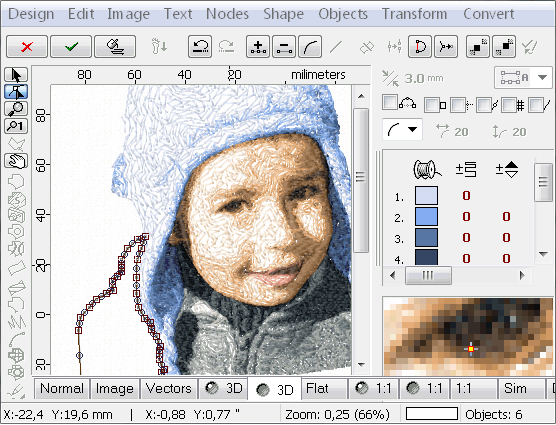Custom Digitizing for Embroidery: Customized to Your Needs
Custom Digitizing for Embroidery: Customized to Your Needs
Blog Article
Grasping the Embroidery Digitizing Refine: Your Ultimate Guide
Embroidery digitizing is a meticulous craft that needs precision and expertise to translate intricate designs into digital layouts for machine needlework. As artisans begin on this trip to master the embroidery digitizing procedure, an extensive understanding of the fundamentals establishes the foundation for quality. Nonetheless, beyond the rudimentary knowledge exists a realm of advanced software application, specialized devices, and nuanced strategies waiting to be explored. By delving right into the nuances of digitizing, one can open a world of imaginative opportunities and elevate their needlework jobs to new heights.

Understanding Needlework Digitizing Fundamentals
Needlework digitizing essentials develop the structure whereupon elaborate designs are equated into machine-readable styles for accurate sewing. This initial action in the embroidery digitizing process is essential for ensuring that the final stitched item is a faithful representation of the original layout. Recognizing embroidery digitizing essentials entails comprehending essential concepts such as stitch types, sew instructions, thickness, underlay, and draw payment.
Stitch types play an essential function in figuring out the aesthetic and textural end result of the embroidered layout. By choosing the ideal stitch type, whether it be satin, fill, or running stitch, digitizers can accomplish the preferred impact and boost the general top quality of the embroidery. Additionally, stitch direction affects the flow and dimension of the style, while thickness identifies the spacing and insurance coverage of the stitches.
Moreover, rug sewing offers security to the layout by securing the material and stopping distortion throughout the embroidery procedure. Draw compensation is one more necessary consideration to combat the all-natural propensity of textile to contract when stitched. Mastering these embroidery digitizing essentials is essential for creating professional-quality embroidered items.
Choosing the Right Digitizing Software Application
Choosing the proper digitizing software is a crucial choice that substantially influences the effectiveness and quality of the embroidery digitizing procedure. Digitizing for Embroidery. When picking the ideal digitizing software, it is crucial to take into consideration variables such as the intricacy of styles you intend to produce, the user-friendliness of the software program, the degree of customer support used, and the compatibility with your embroidery machine
There are numerous digitizing software program alternatives available out there, varying from standard programs for beginners to advanced software program for expert digitizers. Some popular choices consist of Wilcom EmbroideryStudio, Hatch Needlework Software Application, and PulseID. These software offer a vast array of tools and attributes to assist you develop elaborate styles easily.
Prior to deciding, it is recommended to discover the various software application choices through free trials or trials to identify which one best fits your requirements. Furthermore, reviewing reviews and seeking recommendations from skilled digitizers can give useful insights right into the strengths and weaknesses of each software (Digitizing for Embroidery). By very carefully reviewing your demands and contrasting the attributes of different digitizing software application, you can make an informed option that enhances your needlework digitizing workflow
Digitizing Tools and Techniques

Optimizing Style Setup for Embroidery
Mastering the intricacies of layout setups is essential in achieving optimal cause the embroidery digitizing procedure, structure upon the structure laid by understanding digitizing devices and methods. When optimizing style setups for needlework, it is vital to consider elements such as stitch type, thickness, padding, draw compensation, and registration. Sew kind choice affects the general look of the layout, have a peek at this site with alternatives like satin, fill, and running stitches providing various structures and effects. Density describes the spacing and thickness of stitches, impacting the layout's protection and longevity. Correct underlay sewing supplies security and stops material distortion, especially for intricate layouts or on stretchy products. Pull settlement changes for fabric stretch during stitching, guaranteeing accurate layout duplication. Enrollment setups align different elements of the style properly, keeping overall layout integrity. By fine-tuning these layout setups, embroiderers can enhance the high quality and accuracy of their stitched productions.

Troubleshooting Common Digitizing Issues
When encountering usual digitizing issues during the needlework process, it is vital to comprehend the source and carry out reliable solutions promptly. One common trouble is stitch thickness issues, where stitches may be too dense, creating the fabric to tighten, or also thin, resulting in gaps in the style. Adjusting the stitch thickness settings in the digitizing software application can help solve this concern.
An additional regular difficulty is string breaks during the embroidery procedure. This can take place as a result of various factors such as wrong stress settings, plain needles, or utilizing low-grade thread. Ensuring proper upkeep of the needlework machine, including regular needle changes and tension modifications, can reduce the incident of string breaks.
In addition, layout enrollment errors can result in misaligned aspects within the embroidery design. Inspecting the design positioning in the digitizing software and making necessary adjustments prior to sewing can help in avoiding this issue. By addressing these typical digitizing Web Site problems immediately and properly, you can guarantee a smoother embroidery procedure and high-quality finished items.
Verdict
In verdict, grasping the needlework digitizing procedure calls for a strong understanding of the basics, the ideal option of software application, and knowledge of tools and techniques. Optimizing design setups and troubleshooting usual digitizing problems are critical action in guaranteeing premium needlework outcomes. By following these actions vigilantly, one can accomplish precision and performance in the digitizing procedure.
Report this page